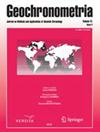日本西部羽滨半岛全新世海滩脊砂的发光年代测定
IF 0.9
4区 地球科学
Q3 Earth and Planetary Sciences
引用次数: 4
摘要
摘要我们将红外激发发光(IRSL50)和后红外(post-IR)IRSL150测年法应用于从日本Yumighama半岛全新世海滩山脊获得的钾长石砂,以研究当地河流流域17-18世纪铁矿开采对海滩进积速率的影响。所有样品都显示出较高的IR后IRSL信号等效剂量。衰落测试表明,IRSL产生相对较高的g值(11-13%/10年),而IR后的IRSL产生负g值(-5%--8%/年)。最老样本的校正IRSL年龄为8.1±1.3 ka,相对于其预期年龄(5–6.7 ka)略有高估。校正后的年龄高度依赖于g值,如果稍有不准确,就会导致高估。未校正的IR后IRSL年龄被低估了,我们认为IR后的IRSL信号减弱了。然而,考虑到负g值,应用适当的衰落校正是不可行的。较年轻样本的校正IRSL年龄,加上残留剂量的假设,与历史海岸线变化大致一致,表明在最近与采矿相关的沉积物流量增加期间,海岸线前积速率显著增加。本文章由计算机程序翻译,如有差异,请以英文原文为准。
Luminescence dating of Holocene beach-ridge sands on the Yumigahama Peninsula, western Japan
Abstract We applied infrared stimulated luminescence (IRSL50) and post-infrared (post-IR) IRSL150 dating to K-feldspar sand obtained from Holocene beach ridges on the Yumigahama Peninsula, Japan, to investigate the rate of progradation of the beach, which has been affected by 17–18th century iron mining in a local river catchment. All samples showed higher equivalent doses for the post-IR IRSL signal. Fading tests indicated that IRSL yielded relatively high g-values (11–13%/decade), while post-IR IRSL yielded negative g-values (–5 to –8%/decade). The corrected IRSL age of the oldest sample, 8.1 ± 1.3 ka, was slightly overestimated with respect to its expected age of 5–6.7 ka. The corrected age is highly dependent on the g-value, which if slightly inaccurate would have caused the overestimate. The uncorrected post-IR IRSL ages were underestimated, and we consider that the post-IR IRSL signal faded. However, given the negative g-values, application of an appropriate fading correction was not feasible. The corrected IRSL ages of the younger samples, coupled with an assumption of residual dose, roughly agreed with the historical shoreline changes, indicating that the rate of shoreline progradation increased markedly during the recent period of mining-related enhanced sediment discharge.
求助全文
通过发布文献求助,成功后即可免费获取论文全文。
去求助
来源期刊

Geochronometria
地学-地球科学综合
CiteScore
2.20
自引率
0.00%
发文量
1
审稿时长
>12 weeks
期刊介绍:
Geochronometria is aimed at integrating scientists developing different methods of absolute chronology and using them in different fields of earth and other natural sciences and archaeology. The methods in use are e.g. radiocarbon, stable isotopes, isotopes of natural decay series, optically stimulated luminescence, thermoluminescence, EPR/ESR, dendrochronology, varve chronology. The journal publishes papers that are devoted to developing the dating methods as well as studies concentrating on their applications in geology, palaeoclimatology, palaeobiology, palaeohydrology, geocgraphy and archaeology etc.
 求助内容:
求助内容: 应助结果提醒方式:
应助结果提醒方式:


